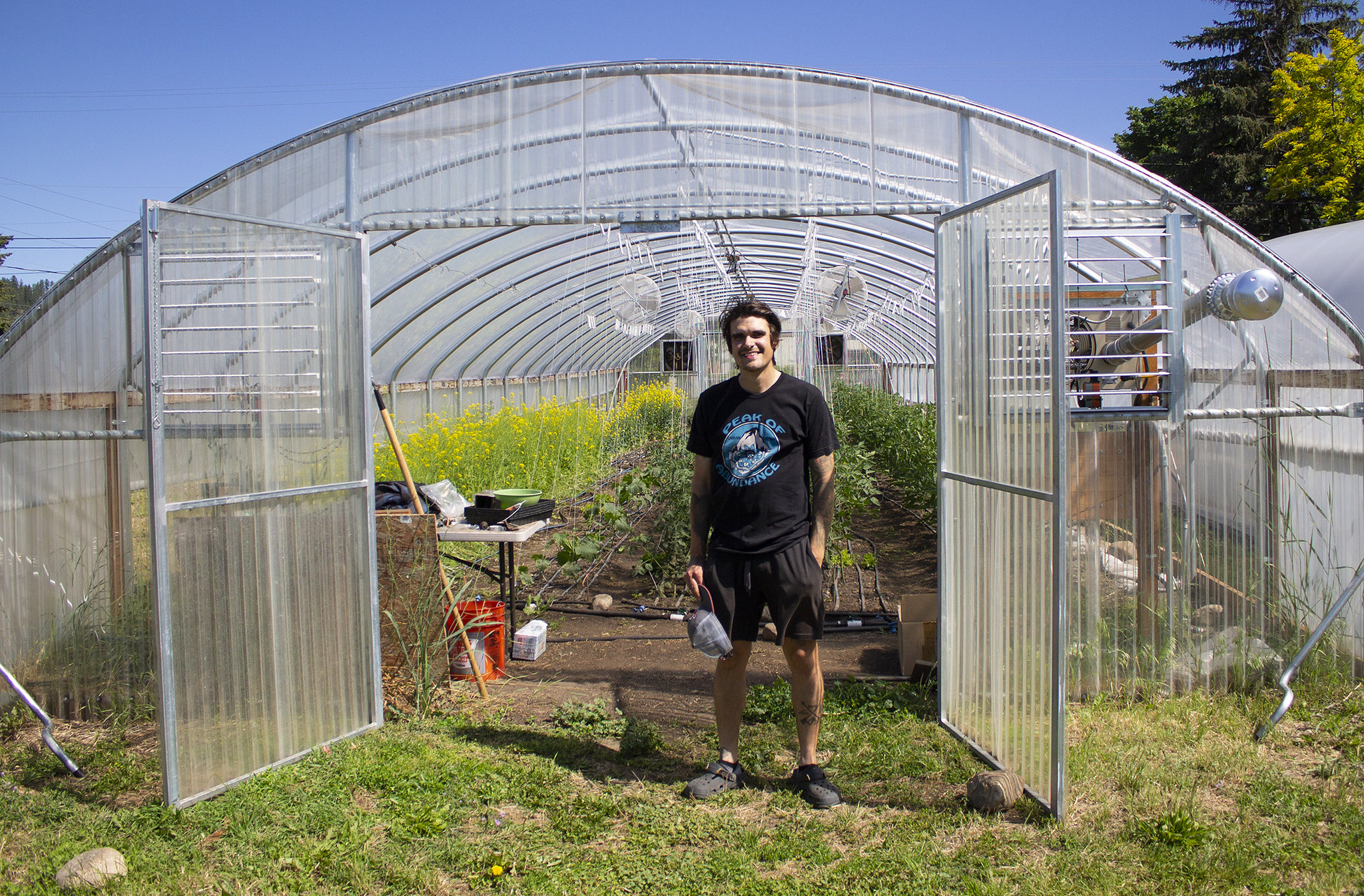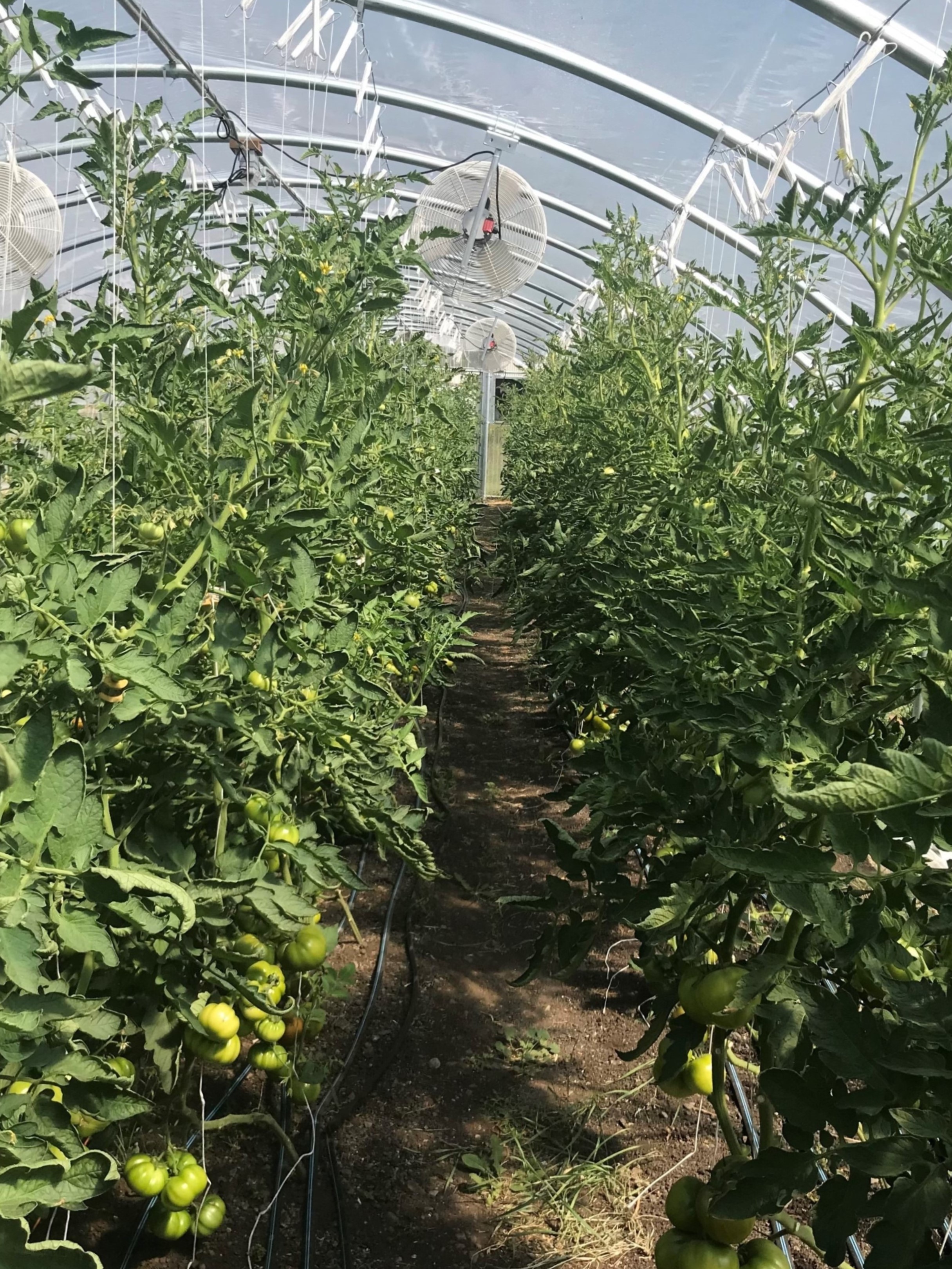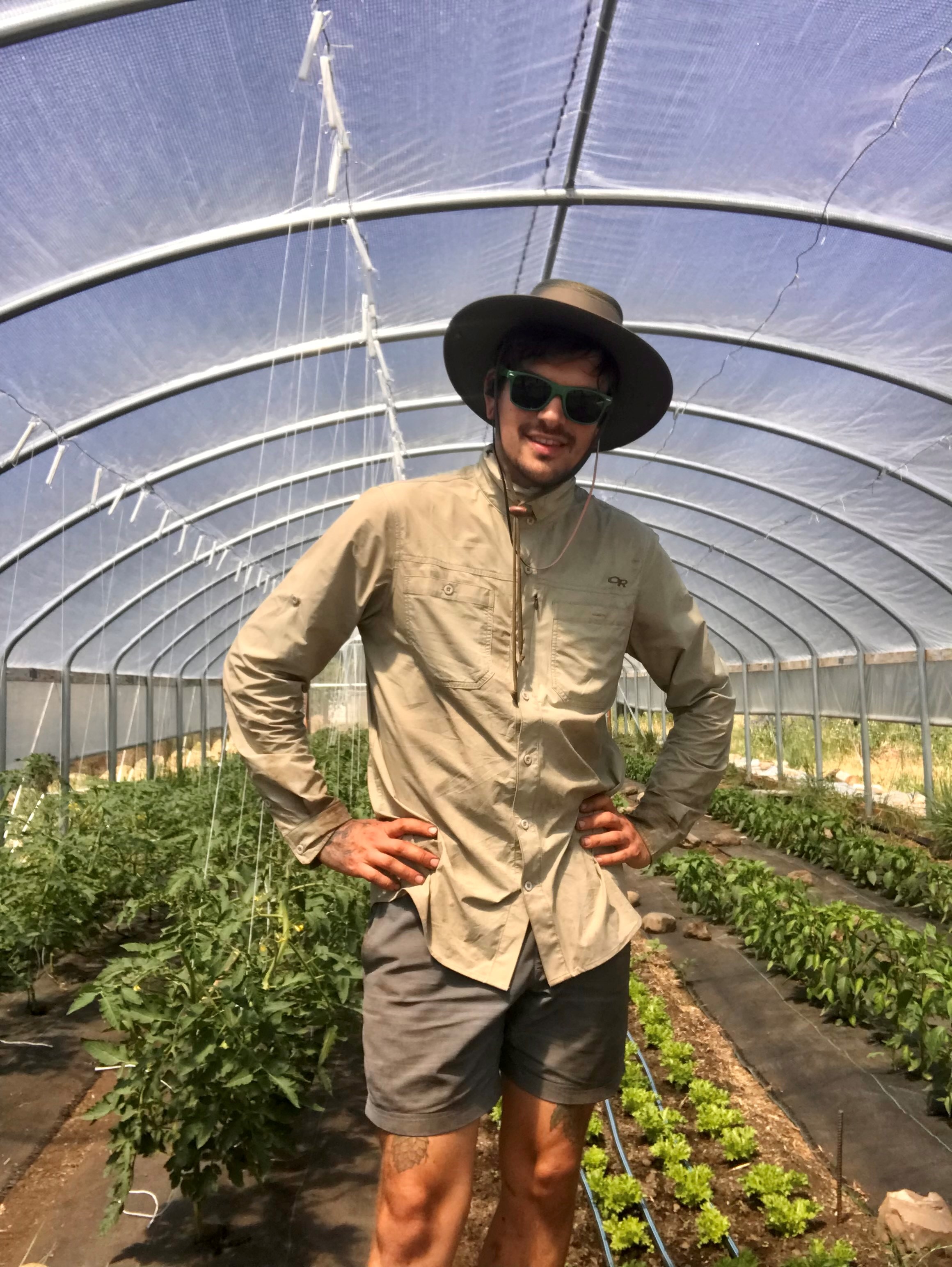Urban farmer Brandon Gerard runs Peak of Abundance Farm, a 0.5-acre urban farm located near Spokane, Washington. Brandon is using high tunnels, shade cloth, and drip irrigation to protect his crops from damage associated with the effects of climate change, including increasing instances of extreme heat, drought, and wildfire smoke. Implementing actions that can help urban farmers adapt to climate change could contribute to improved food security and climate resilience.
Reading Time | 5 minutes
Management Goals | Shelter crops from wind and heat damage on urban farm.
Audience | Farmers, NRCS, Extension, Farm advisors
Project Contact | Brandon Gerard
Project Area | Peak of Abundance Farm, Spokane, WA
Funding | See funding section
Increasing climate resilience on an urban farm

Brandon Gerard has operated Peak of Abundance farm in the Spokane Valley for six years. Peak of Abundance grows greens, root vegetables, beans, eggplant, garlic, sweet peppers, summer squash, and tomatoes. Brandon sells his produce through Community Supported Agriculture (CSA) at LINC Foods (Local Inland Northwest Cooperative) and at local farmers markets. When possible, he contributes to the We Feed Washington program, which provides emergency food for people experiencing hunger through partnerships with local producers.
Urban farmers in the Northwest already face challenges, from high startup costs to difficultly purchasing affordable, arable land. As such, the additional challenges of climate change can feel overwhelming to beginning urban farmers. Brandon provides an example of methods urban farmers can use to adapt to mounting challenges, and enrich their crops and land. For example, Brandon uses high tunnels, shade cloths, and drip irrigation to adapt to rising temperatures and extreme events. High tunnels protect his crops from storms, particularly windstorms, and drip irrigation conserves water and protects crops from drought. Shade cloths protect vulnerable crops during extreme heat events. Brandon also uses no-till or minimal tillage and locally produced, organic compost as much as possible.
Extreme heat, wildfire smoke, and drought affect crops
Brandon’s farm has experienced extreme heat events, windstorms, and wildfire smoke, all of which have impacted his crops. In the Northwest, changes in climate are expected to cause increased temperatures, changes to precipitation patterns, an increase in the likelihood of extreme events (e.g., heatwaves and unpredictable frost events), and increased exposure to wildfire smoke.
During the June 2021 Heat Dome, when temperatures reached well into the 90s, the growth of brassicas (e.g., Brussels sprouts, cabbage) on the farm slowed. The following year, an unusually cool spring delayed plant germination. Severe windstorms have impacted his crops every year since he started farming in 2016. In years with heavy wildfire smoke, crops receive less light for photosynthesis, and he has seen his tomatoes and many other crops ripen more slowly as a result. Wildfire smoke can also change how quickly water evaporates from plants, and can increase disease pressure on plants.
Strengthening climate resilience on Peak of Abundance farm

Brandon constructed high tunnels for protection against windstorms, extreme heat events, and unpredictable early or late-season frosts. High tunnels are plastic or fabric covered hoop structures that can be constructed at a lower cost than greenhouses. They can protect crops from sun, wind, excessive rain, and cold, and can be used to extend the growing season of plants. In addition, the sides of high tunnels roll up for increased ventilation on hot days. In a windstorm, the sides can be rolled down to prevent wind damage to crops. High tunnels have effectively protected his crops during windstorms and extreme heat. With the help of EQIP (Environmental Quality Incentives Program), Brandon bought the materials for the high tunnel and easily constructed the tunnels.
High tunnels can be covered with shade cloth to protect vulnerable root vegetables and leafy greens like carrots, spinach, and lettuce from sun and extreme heat. Brandon uses shade cloth on his tomato and cucumber house, and notes that it seems to work well in protecting his plants from sun damage. Shade cloth can also be used over hoops to protect individual rows of vegetables. Brandon implemented this practice in 2021 for leafy greens but says “it’s a ton of work for a crop that isn’t in the ground that long.” He says he “probably wouldn’t do it again” for those crops.
Recently, Brandon added an automatic ventilation fan to his greenhouse to improve crop resiliency to extreme weather. Automatic ventilation can be set to turn on at a certain temperature, so when a farmer is out of town or busy, the ventilation can cool the greenhouse or high tunnel automatically. Brandon plans to add automatic ventilation to one of his high tunnels this year.
With the help of another EQIP contract, Brandon installed drip irrigation in all his high tunnels. Drip irrigation uses plastic tubes to frequently deposit small amounts of water on or below the soil surface, negating evaporative water loss from overhead sprinklers. Brandon uses overhead sprinklers rarely in the high tunnels, and only then to cool down leaves for a few minutes on hot days and right after seeding to evenly moisten the seedbed. Drip irrigation “is super easy to work with” and can be set up in a day, Brandon comments, depending on the farm size.
Challenges and opportunities
Though Brandon considers the impacts of climate change a formidable threat, he says the pressing challenges of urban farming have more to do with taxes, sales, and distribution than climate change adaptation. Larger farms qualify for agricultural tax breaks that Brandon’s small, 0.5-acre urban farm does not. As a result, his taxes are “very high.” Even purchasing the land for an urban farm is a daunting prospect for many beginning farmers.
Trying to find sales outlets for a small farm can also be challenging. As a small farmer, Brandon says “you have to grow good food, adapt to agricultural challenges, and be a savvy businessperson. There are just very few outlets for small farms, so you have to work extra hard.” He hopes that a sales model for small farms comes about that can rejuvenate local food systems and reach more of the public. More advertising for local produce, food assistance acceptance on small farms, and more locally run co-ops could provide some relief, he believes.
Brandon notes that a lot of “farmers are aging out and retiring, and opportunities for small farmers are becoming harder because of access to land and the lifestyle commitment. If we don’t replace these aging farmers, we will have a gap in agricultural knowledge.” In a time of changing climate, an agricultural knowledge gap could be a major concern. Brandon wants farming to be elevated as a viable career option for young people. “You won’t make the most money,” he says, “but you’ll wake up every day and think that you’re doing something worthwhile.” Brandon knows that “everything moves slow on farms.” But he doesn’t think we “need a fast-moving ship. We just need to start heading in the right direction.” He believes small farming communities can be a point of engagement: “Carrots are always going to be carrots. Beets aren’t hollow in the middle like a bag of chips. Vegetables will always be ‘what you see is what you get.’” He thinks this principle could reconnect communities with the land and enliven a sense of concern for the impacts of climate change.
Funding
Brandon has received funds through the EQIP program which provides financial and technical assistance to agricultural producers to address natural resource concerns and deliver environmental benefits, such as improved water and air quality, conserved ground and surface water, increased soil health, and reduced soil erosion and sedimentation, improved or created wildlife habitat, and mitigation against drought and increasing weather volatility.
An EQIP contract funded his first few high tunnels, and a second contract is going to fund three new tunnels, including a 20 x 80 feet, temperature-controlled high tunnel for cucumbers and tomatoes. He discovered the opportunity through his local Natural Resource Conservation Service agent. Brandon encourages farmers to apply for more than one EQIP contract if they qualify.
Additional information

Peak of Abundance Instagram provides updates on Peak of Abundance farm and crops.
Local Inland Northwest Cooperative – for more information about producers in the Spokane area, or to purchase a CSA that includes Peak of Abundance crops, visit LINC.
How to Start a Farm: Beginning Farmers and Ranchers is a USDA webpage that serves as a guide to beginning farmers.
NRCS Washington can provide information to producers on management actions and grants in Washington.
USDA Agricultural Marketing Service Farmer’s Market Promotion Program funds projects that encourage direct producer-to-consumer markets to increase access to and availability of locally and regionally produced agricultural products.
USDA Urban Agriculture Programs at a Glance brochure provides information about funding, marketing, and expanding food access for urban farms and gardens. The Urban Agriculture Toolkit lays out the common operational elements that most urban farmers must consider as they start or grow their operations.




